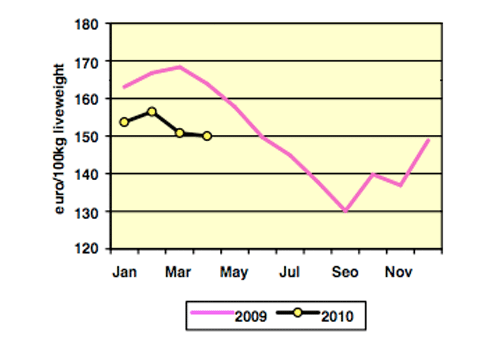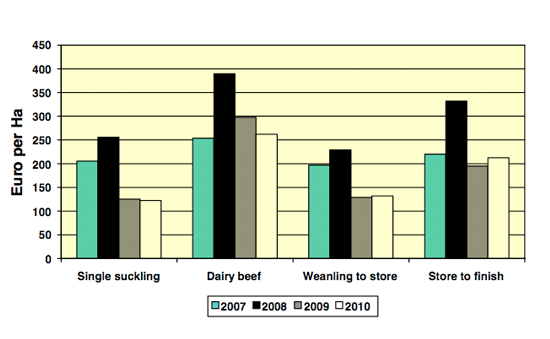



Irish Situation And Outlook For Beef
This paper considers the economic situation on four Irish cattle enterprises in 2010. The four enterprises examined are single suckling, weanling to store, store to finish and cattle rearing on dairy farms.At the mid point of 2010 indications are that direct costs of production are set to decrease in 2010. With gross output on most enterprises likely to decline due to lower cattle prices, gross margins are unlikely to change dramatically when compared with 2009.
At the mid point of 2010 indications are that direct costs of production are set to decrease in 2010. With gross output on most enterprises likely to decline due to lower cattle prices, gross margins are unlikely to change dramatically when compared with 2009.
On weanling to store and store to finish enterprises, concentrates typically account for over 40 per cent of direct costs. Expenditure on concentrate feed costs as a proportion of total direct costs are generally lower, circa 30 per cent, on single suckling enterprises. Cattle meal prices fell dramatically over the second half of 2009, and despite increases in feed prices during the first half of 2010, the price of concentrate feed s in 2010 is forecast to be 10 per cent lower than the average price level in 2009.
Data for the first quarter of 2010 provided by DAFF indicate that aggregate cattle feed purchases are up about 8 per cent on the levels in the first quarter of 2009. This increase may reflect the higher volumes of feed that can be purchased at lower prices by farmers who operate on a fixed feed budget, but is more likely due to the shortage of fodder following the very wet autumn of 2009 and the impact of the very cold 2009/2010 winter which saw cattle kept in sheds for longer than usual. During the remainder of 2010 feed purchases will continue to be affected by weather. Baring a significant deterioration in weather, we expect the annual volume of feed purchased to be 5 per cent higher than in 2009. Taking account of the lower feed price and higher usage level, expenditure on concentrate feeds by cattle farmers is expected to decline by almost 5 per cent in 2010.
The share of pasture and forage costs in direct costs on Irish cattle enterprises varies from over 50 per cent of direct costs on single suckling enterprises to around 35 per cent on weanling to store and store to finish enterprises. Fertiliser spreading costs, the costs of silage making (contractor and own) and other energy intensive farming activities look set to increase in 2010 relative to 2009 due to increases in the price of agri -diesel and the introduction of the carbon tax. Despite a moderate increase in the price of CAN over the course of the first half of 2010, average fertiliser prices in 2010 will be significantly below those paid in 2009. For the year as a whole, fertiliser prices are forecast to be 10 per cent lower than the average price level in 2009, due to increased energy costs overall pasture and forage expenditures are forecast to decline by 3 per cent in 2010.
Cost items such as energy and fuel, electricity and labour, account for relatively small shares of the total costs of production on cattle farms. In 2010 these costs, with the exception of energy and fuel, are expected to decline relative to 2009. The imposition of the carbon tax as well as higher international energy prices are expected to lead to energy expenditure increasing by 10 per cent over 2009. Given the ongoing weakness in the Irish labour market, labour costs are not expected to increase relative to 2009 levels.
Relative to 2009, the forecast decline in 2010 of total direct costs per hectare range from 4 per cent for the weanling to store and store to finish enterprises to 2 per cent for the dairy beef enterprise. The smaller decline in direct costs on the dairy beef enterprise reflects the different mix of inputs in this enterprise (particularly the greater importance of milk and milk substitutes) when compared with the other cattle enterprises.
Cattle prices on Irish and EU cattle markets have been lower in 2010 than 2009. Despite the contraction of overall EU beef supplies, weak demand over the first half of 2010 due to the ongoing recession and a small increase in EU imports of beef have combined to leave European and Irish cattle prices down on levels observed in 2009. As of July 2010, finished cattle prices (R3 steer) are 3 per cent lower than in 2009. The prices of weanlings and store animals in the first half of 2010 are between 3 and 5 per cent lower than over the same period in 2009, while calf prices in the first half of 2010 were 3 per cent lower than price in the same period in 2009.
Figure 1: Irish Calf prices

Figure 2: Irish Weanling prices

Figure 3: Irish Store cattle prices

Figure 4: Irish Finished cattle prices

The level of throughput in meat plants and the volume of live exports during the first half of 2010 was significantly higher than 2009, with overall disposals up 20 per cent. This suggests that in the autumn of 2010, with lower supplies of finished cattle, that Irish cattle prices may be higher than would otherwise be expected. Despite this expected improvement in cattle prices later in the year average annual prices are still expected to be lower than in 2009. The introduction of quality payment system (price grid) had led to changes in the relative prices of different grades of cattle in Ireland. However, the lower level of finished cattle, calf and weanling prices in Ireland largely reflects the lower cattle prices on Ireland’s export markets in the EU that are due to the weaker demand for beef from consumers.
Figure 5: Irish Live cattle exports

Figure 6: Irish Cattle slaughter

Based on data available in July 2010, we estimate that gross output per hectare on the single sucking (inclusive of the coupled Suckler Cow Welfare Scheme payment) and dairy beef enterprises will decline by 3 per cent relative to 2009. The level of gross output on the weanling to store fattening system is forecast to decrease by 2 per cent and increase by almost 1 per cent on the store to finish system. The declines in the gross output earned on the single suckling, dairy beef and weanling to store enterprises reflects the lower prices for calves, weanlings and s tores sold in 2010 compared with 2009. As noted earlier the introduction of the QPS has altered the relative price relationships across different grades of finished cattle. Given that cattle from the dairy herd are, other things equal, less likely to reach grades that under the QPS command a premium, this will lead to lower gross output valued for this system compared with 2009. On the store to finish enterprise the larger decline in the price of animals purchased in allows these farms to earn a higher leve l of gross output in 2010 than in 2009.
On all cattle systems expenditure on concentrates and pasture and forage is forecast to be lower in 2010 than 2009. On the dairy beef system the impact of higher milk prices on expenditure on milk and milk substitu tes is sufficient to lead to a marginal increase in the overall direct costs per hectare on this system. On the three other cattle systems analysed direct costs in 2010 are forecast to be lower than 2009. On the single suckling enterprise the decline in direct costs is insufficient to fully offset the decline in the value of gross output per hectare and gross margins are forecast to decline by 2 per cent relative to 2009. On the dairy beef enterprise higher direct costs (due to increased prices of milk and milk substitutes) when combined with lower gross output, lead to a forecast decline of 12 per cent in the gross margin per hectare.
On the cattle finishing systems the impact of lower prices for cattle sold will be at least partially offset by the forec ast lower price of calves and weanlings purchased in 2010. This means that these enterprises should see gross margins earned in 2010 increase over levels in 2009. The store to finish enterprise gross margin increase over 2009 at 9 per cent is the highest since the forecast decline in finished cattle prices in 2010 is expected to be less than the decline in the price of cattle purchased in (stores).
The magnitude of the absolute changes in the value of gross output and direct costs on Irish cattle enterprise s from 2009 to 2010 is not forecast to be dramatic, though the low levels of gross margin earned on all cattle enterprises means that relatively small shifts in the level of direct costs and/or gross output can lead to seemingly large per centage changes. The value of gross output on three of the four cattle enterprises analysed is forecast to decline between 2009 and 2010. On the weanlings to store and store to finish enterprises the forecast decline in direct costs in 2010 is sufficient to lead to an increase in gross margin earned in 2010 when compared with that earned in 2009. However, on the single sucking and dairy beef enterprises the forecast fall in direct costs in 2010 will be insufficient to lead to an increase in gross margin per hectare. Overall, the problems of low to negative levels of profitability in Irish beef production are forecast to persist in 2010.
Readers should recall that enterprise gross margins do not account for all of the costs of production. If farm overhead costs, which are di fficult to allocate across different farm enterprises, were deducted from farm gross margins, the net margin earned on most Irish cattle farms (which excludes decoupled direct payment receipts) would be negative.
Figure 7: Gross margin per hectare for I rish Cattle Enterprise 2007 to 2010

Further Reading
| - | You can view the full report by clicking here. |


